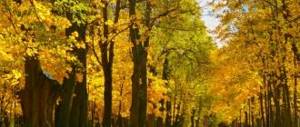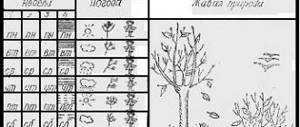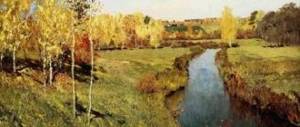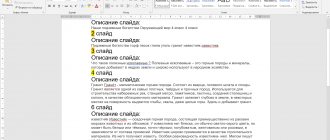For the comprehensive development of preschoolers in kindergarten and primary schoolchildren, it is extremely necessary to pay attention to the natural changes of the seasons: spring, summer, autumn, winter. For example, with the beginning of autumn and the new school year, you can conduct a lesson “Autumn changes in nature,” visually explaining the topic of learning in the park during walks or in class using material collected in advance. Older children keep a calendar of weather changes by drawing icons and making comparisons with previous years. It records autumn changes in nature (pictures and herbarium are attached). On the topic of the lesson, children should pay attention to the following points.
Golden autumn
In central Russia, autumn is truly “a charm of the eyes,” as the poet said. The heat and stuffiness of summer is replaced by a slight coolness. The days are getting shorter and the nights are getting longer and darker. Trees are the first to respond to these autumn changes in nature. The leaves turn yellow and red, then slowly fly away, covering the entire area with a multi-colored carpet. The period of golden Indian summer begins, when nature still pleases with moderate sunshine, when late fruits are already ripening, filled with both sweetness and aroma, but the nights are already becoming colder and colder.
Leaf fall
This majestic and colorful natural phenomenon is associated with biological changes that occur in almost all wild trees during the cold periods of the year. The foliage falls and thus allows the plants to rest and prepare for a long winter hibernation, when all life processes inside the tree are suspended and the juices stop circulating. Without leaves, trees use much less water and do not accumulate a lot of snow on their branches during snowfalls. This means that the risk of mechanical damage is reduced. In addition, along with the leaves, plants shed all kinds of pests, which then die during the period when cold weather sets in. We can say that autumn changes in nature begin with the fall of leaves. But this is in living nature (after all, trees are also living beings with the ability to breathe and grow). How are the autumn changes in inanimate nature associated with the imminent onset of cold weather?
Objects and phenomena of living and inanimate nature in autumn: description of observations
On the territory of our country one can often observe changes in the weather and nature, which “adjusts” to the coming changes. Many of the phenomena that we observe are associated specifically with the seasons and are therefore called seasonal. One of the most beautiful times of the year is autumn.
During this period, nature is painted with golden colors, all animals and plants are preparing for the cold winter and you can observe the most amazing changes and phenomena. Autumn is characterized by the following main changes:
- Fogs. This phenomenon can be explained by the fact that the earth heats up during the day, and at night the temperature is already below zero, so fog, dew and even frost are observed with sunrise
- Shower. Autumn is associated with rainy weather, and it is during this period that heavy rains are observed - in other words, downpour
- Wind. It is in the fall that when you go outside you can encounter strong gusts of wind, which are often accompanied by rain or even hail.
- It gets dark earlier
- Cloudy weather
- You can see thin ice on ponds and puddles, but standing on it, much less playing on it, is very dangerous; it’s better to wait until winter
- The onset of winter can also be characterized by “Indian” summer. During this period, a heavy milky fog falls to the ground, filling the air with dampness.
- At the end of autumn, rainy weather is diluted by light snowfall, after which there is often ice
Golden autumn
This is a characteristic of inanimate nature that can be observed in the fall, but changes in living nature include:
- Animals such as fox, squirrel and hare change their color
- Many animals hibernate in late autumn
- Birds fly to warmer climes
- Insects also hide from the cold weather, you can no longer see butterflies and ladybugs, you can’t hear the whistle of grasshoppers, bees don’t buzz and don’t pollinate plants, mosquitoes and flies are also becoming less and less common
- Leaf fall. This is the first sign that golden autumn is coming. The castings turn yellow, and with a strong gust of wind, trees and bushes are freed from them. All roads are covered with a beautiful golden carpet
Autumn is a wonderful time of year that prepares nature and people for the cold frosty winter. This time gives us a break from the hot and stuffy summer days. But the first ones who begin to respond to climate changes are plants. Berries and vegetables are fully ripening, and the trees are dressed in golden foliage.
Fogs
Indian summer is a short period, usually ending with the onset of October. The first signs of inclement weather are already appearing. Fogs, thick, sticky, reminiscent of milk in appearance, fill the autumn nature with dampness and a musty smell. In its essence, fog is a thick cloud that, as a result of temperature changes, forms at the very surface of the soil. As soon as it gets warmer, the fog will clear. The moisture will fall on the withered grass and foliage in the form of frost (if the ground has already cooled sufficiently).
Presentation on the surrounding world “Natural Phenomena”.
Natural phenomena
2nd grade
Completed by: primary school teacher
Kholyavko Oksana Ivanovna
MBOU Secondary School No. 6, Noyabrsk
Rain
Rain is precipitation that falls in the form of water droplets. The water droplets in the clouds become too heavy and begin to fall to the ground. If the drops are small, it is drizzling, and if they are large, it is torrential. Very heavy torrential rain is called a downpour.
A thunderstorm
is when lightning flashes in the sky and thunder is heard. Lightning is a giant electrical spark in the sky, and thunder is the sound of a discharge.
A rainbow
can appear in the sky when it is raining and the sun is shining. It is visible when the sun's rays pass through raindrops.
Dew
is droplets formed on plants, soil and various ground objects. It appears only in clear skies.
Wind
is the movement of air. When air from the ground heats up, it begins to rise, and cold air sinks. The wind cannot be seen with the eyes, it can only be felt. The wind can be strong, weak, cold, refreshing, warm.
Fog
—
it is something like a veil of tiny drops of water, sometimes mixed with smoke and dust. Sometimes the fog is so thick that it is very difficult, even impossible, to see anything. Fogs are more common in autumn, when the air cools faster than the land and water. Urban fogs are thicker than rural fogs, because the air in the city is full of dust and soot, which, when combined with water particles, form a dense blanket.
hail
When raindrops rise and fall in a vortex of cold air, freezing more and more, hail forms. And no longer drops fall to the ground, but solid balls.
Frost
is very small crystals that look like tiny snowflakes.
Most often, frost falls on cold, clear and quiet nights. It is formed in calm weather and with a light breeze and covers the ground, plants, stones, walls of houses and benches...
They say that frost is solid dew.
Snowfall
is precipitation that falls in the form of snow in winter. At high altitudes, the vapor in the snow clouds begins to freeze and turns into small ice crystals. These crystals make snowflakes.
A blizzard
, or blizzard , begins when strong winds blow during a snowfall. He pushes and spins snowflakes.
ICE
Ice forms from water when the temperature drops to zero or below.
ICICLES
Look, the snow on the slope of the roof is melting because the sun's rays heat it to a temperature above zero.
And the flowing drops of water at the edge of the roof freeze, because the temperature under the roof
below zero, cold.
Thawed water flows down and hangs in drops over the edge, cools and freezes.
The next drop flows onto the frozen drop, also
freezing, then a third drop, and so on. Gradually a small ice bump forms.
Another time, in the same weather, these ice flows lengthen even more - this is how icicles form.
It's warm and the snow is melting
The temperature is below zero, it’s cold, the drops are freezing.
Internet resources
https://detsad-kitty.ru/shablon/52129-oformlenie-ugolka-prirody-prirodnye-yavleniya-2.html
https://900igr.net/photo/priroda/5-JAvlenija-3.files/019-Inej.html
https://yandex.ru/images/search?img_url=http%3A%2F%2Fxn
https://www.beset.ru/index.php?m1=30&m2=50&id=977591
https://pozitiff-ko.ucoz.ru/forum/21-71-1
https://www.yakutian-laika.com/t553-topic
https://www.copywriter-yastrebova.com/category/nature-reveals-its-secrets/ page/3/
https://prettydinochka.beon.ru/
https://siemenssuper.narod.ru/
https://vk.gdefon.ru/gdefon/wallpaper/site/demo_url_for_api/id/354197/name/zima_les_inej/
https://zastavkin.narod.ru/nature/nature/1×1/hoar-frost02.html
https://wap.mms.mts.ru/contents/5488028?ct=photos
https://news.vtomske.ru/news/62886.html
Frost
The topic of autumn changes in inanimate nature also includes such a phenomenon as frost. Essentially, these are small particles of dew frozen in the form of snowflakes. They cover all surfaces with a thin, uneven, prickly layer. This indicates that the first frosts and negative temperatures have appeared in the atmosphere.
Spring natural phenomena
In the spring, after a long winter, the sun warms up more and more, ice begins to drift on the river, thawed patches appear on the ground, buds swell, and the first green grass grows. The days are getting longer and the nights are getting shorter. It is getting warmer. Migratory birds begin their journey to the region where they will raise their chicks.
What natural phenomena happen in spring?
Snowmelt. As more heat comes from the Sun, the snow begins to melt. The air around is filled with the murmur of streams, which can trigger the onset of floods - a clear sign of spring.
Thawed patches. They appear wherever the snow cover was thinner and where more sun fell on it. It is the appearance of thawed patches that indicates that winter has given up its rights and spring has begun. The first greenery quickly breaks through the thawed patches, and on them you can find the first spring flowers - snowdrops. The snow will lie in crevices and depressions for a long time, but on the hills and fields it melts quickly, exposing the islands of land to the warm sun.
Frost. It was warm and suddenly it froze - frost appears on the branches and wires. These are frozen crystals of moisture.
Ice drift. In spring it becomes warmer, the ice crust on rivers and lakes begins to crack, and the ice gradually melts. Moreover, there is more water in reservoirs, it carries ice floes downstream - this is ice drift.
High water. Streams of melted snow flow from everywhere to the rivers, they fill reservoirs, and the water overflows its banks.
Thermal winds. The sun gradually warms the earth, and at night it begins to give off this heat, and winds are formed. They are still weak and unstable, but the warmer it gets around, the more the air masses move. Such winds are called thermal; they are characteristic of the spring season.
Rain. The first spring rain is cold, but not as cold as snow 
Storm. The first thunderstorm may occur at the end of May. Not so strong yet, but bright. Thunderstorms are discharges of electricity in the atmosphere. Thunderstorms often occur when warm air is displaced and lifted by cold fronts.
Hail. This is the fall of ice balls from a cloud. Hail can be anywhere from the size of a tiny pea to a chicken egg, and can even break through a car window!
These are all examples of inanimate natural phenomena.
Flowering is a spring phenomenon of living nature. The first buds appear on the trees in late April - early May. The grass has already sprouted its green stems, and the trees are preparing to put on their green outfits. The leaves will bloom quickly and suddenly and the first flowers are about to bloom, exposing their centers to the awakened insects. Summer is coming soon.
Read more about spring, spring natural phenomena and weather signs >>
Winds and clouds
In autumn, a cold front in the atmosphere brings with it colder air masses. The winds react to this and change their direction, intensifying, bringing bad weather and precipitation. This time of year sometimes becomes slushy and long, causing autumnal changes in nature.
In turn, cumulonimbus clouds bring huge amounts of precipitation. If the temperature changes sharply enough, then at the beginning of autumn you can feel strong winds, see and feel rain and snow, as a consequence of the appearance of a cold cyclone.
Message Summer natural phenomena
Summer is a wonderful time of warm rains, thundering thunderstorms, incredible beauty of the rainbow, and refreshing dew.
In addition to the stifling heat, every summer, nature gives you the pleasure of refreshing torrential rains. Which promotes abundant growth of local vegetation, helping to grow a good harvest. There are several types of summer rains:
1. Normal rain. Drops out without any distinctive feature.
2. Short rain. It lasts for a very short time. It comes unexpectedly and ends the same way.
3. Mushroom rain. During it the sun shines, the mushroom rain does not last long and for a short duration.
4. Heavy rain. This is quite a sudden rain. In a short period of time, a fairly large amount of precipitation falls. In such rain you can also observe lightning, thunder and feel strong winds.
Most often, showers are accompanied by thunderstorms. This phenomenon occurs in cumulonimbus clouds, producing electrical discharges called lightning. But a thunderstorm is considered one of the most serious natural phenomena, sometimes bringing death to humans.
A lightning strike instantly kills or causes great damage to people. During thunderstorms, floods most often occur, which are also very dangerous for the local population. In big cities, sometimes storm drains fail, and houses are forced to be flooded. As a result, enormous damage is caused to property. And people are left without places to live.
5. City-shaped. Rain accompanied by hail. These are pieces of ice falling from the sky. Its sizes vary from very small to half a kilogram in weight. The latter destroy crops, crops, cars and small livestock.
The winds in summer also differ in nature. A squally wind warns of an impending thunderstorm.
One of the most amazing phenomena of summer is the rainbow. It occurs after rain, but there is no denying that it cannot occur during it. It all depends on the rain clouds. The rainbow spectrum has 7 colors. And its occurrence occurs from short-term rains.
Another wonderful phenomenon is called dew. Cooling at night and heating up in the morning, drops of water appear on the entire surface of the earth.
Ice drift and glaze
At the end of November, sometimes the air temperature drops to negative values. The water surface of various reservoirs is frozen by the first crusts of ice. This most often occurs in ponds and lakes where there is almost no current. The ice is not yet completely strong, so the wind and currents carry it away, forming the so-called autumn ice drift.
The ice that covers the soil in mid- and late autumn is formed by light frost, which prevents rain from turning into snow. The ground has not yet cooled enough to be covered with a blanket of snow, a harbinger of severe frosts.
By observing autumn changes in nature, you can learn how the transition to the winter period of life, cold and snowy, is being prepared. When everything around seems to freeze until next spring and the onset of warm days.
Autumn changes in wildlife
- We already talked about leaf fall in trees and its importance for the life of plants at the beginning of the article. It should be emphasized that trees also belong to living nature, since they live and die, breathe and give birth. For plants, autumn is a thorough preparation for the winter period, when all of them (living in natural conditions) go into hibernation: vital activity and the exchange of juices decreases many times over.
- With the onset of cold weather, insects hide and hibernate. This is a protective reaction to lower temperatures. Many insects (such as flies and beetles) crawl into cozy crevices and appear dead at first glance. But that's not true. When spring comes, they will come to life and fly again.
- Cold-blooded animals "fall asleep" as a result of the fact that they cannot maintain the temperature necessary for existence. Snakes, frogs, reptiles and amphibians all hibernate in late fall.
- At the very beginning of autumn, birds prepare to fly to warmer climes. Then their flight begins. Wintering birds do not fly anywhere and feed intensively in the autumn forests.
- Some mammals also hibernate in late fall and early winter. But this is most likely due not to the onset of cold weather, but to the lack of food supply for them in winter. Such animals include: bear, badger, marmot, hedgehog, some rodents (gopher, hamster, dormouse).
- Hibernating mammals intensively accumulate weight in order to use their own fat for warmth and nutrition during the winter cold.
Thus, the animal world is preparing for the approach of the winter cold period, reacting differently to autumn changes in nature.
Dew
In calm weather, as a result of cooling at night and warming in the morning with the first rays of the sun, droplets of water form on the surface of the earth, grass, flowers and other plants and objects. This meteorological phenomenon is called dew. At night, the earth's surface cools. As a result of this, steam in the air begins to condense and turn into water, settling on objects. It is generally accepted that dew forms only when the sky is clear and the wind is light. It is worth noting that the lower the temperature, the larger the droplets will be.
Most often, this phenomenon occurs in the tropics, where it is accompanied by a humid climate and long, cold nights.







